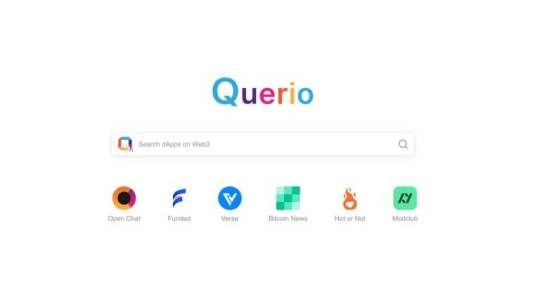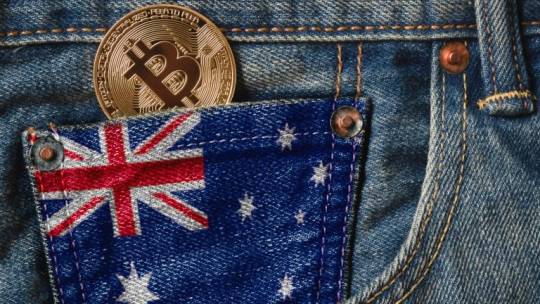Text
Querio: The Daring Upstart on a Mission to Revolutionize Decentralized Search

The story of Querio began in early 2023 at CrossChain Labs, a dynamic startup led by Andreea and George, two forward-thinkers, former ConsenSys employees with a wealth of experience in cutting-edge blockchain ecosystem. They founded CrossChain Labs and collaborated with prominent blockchain platforms such as Near Protocol, Filecoin, Dfinity, Stellar, Fantom, and Polkadot.
During a pivotal meeting at ICP.lab Business Booster, a significant gap in the market was identified: the absence of a dedicated on-chain Web3 search engine for exploring diverse dApps across various blockchains.
Driven by their unwavering belief, Andreea and George embarked on a bold mission in early 2023 to create Querio. They launched Querio as a fully functional Web3 search engine in May 2023, a remarkable achievement made possible through self-funded efforts and determination.
What Makes Querio Different: Core Features and Technical Capabilities
Even in its initial release, Querio introduced several core features that redefined the user experience:
Multi-Blockchain Support: Starting with Internet Computer, Ethereum, Stellar, and NEAR Protocol, Querio offers the flexibility to explore decentralized applications across a diverse range of blockchain networks.
Transparency: Querio displays the number of search results returned and the duration of each search, offering transparency and insights into its performance.
Multi-Word Searches: Unlike traditional single-keyword searches, Querio allows users to enter multiple words for more precise and relevant results.
User-Friendly Design: dApp logos alongside results make it easy for users to identify the source of information. Autocomplete suggestions and summarized content snippets optimize search efficiency.
Smart Ranking Algorithm: The search engine leverages a proprietary ranking algorithm optimized to surface the most relevant results, improving the overall search experience.
The combination of these features provides users with a more productive and satisfying search experience surpassing that of other early Web3 search engines, and demonstrating Querio’s technical prowess and user-centric design.
The Quest to Decentralize: Transitioning Querio to a DAO
The Querio team is actively transitioning the platform into a decentralized autonomous organization (DAO) powered by the Internet Computer blockchain. This includes:
Public Presale: The Querio team has announced an upcoming public presale of QRO tokens to begin on 25th of October, offering 10% of the total QRO supply. This move reflects their commitment to involving the community in the project’s governance and evolution.
Governance Token (QRO): A native governance token, QRO, will be created and distributed to engage a community of stakeholders who will collectively govern the Querio DAO. The target launch time frame for fully transitioning Querio to a DAO on the Internet Computer is Q4 2023 using the SNS launch platform
The Road Ahead: Querio’s Vision for the Future
Beyond decentralizing Querio, the development roadmap extends to expanding functionality and solidifying Querio as the premier platform for users to explore and engage with Web3.
Planned features and capabilities include:
Expand Multi-Blockchain Support: Expanding across additional blockchain ecosystems.
Decentralized Content Miners: A network of independent content miners will be introduced to proactively index Web3 content, ensuring Querio’s search coverage remains comprehensive and up-to-date, with incentives for contributors.
dApps Explorer: Discover the newest and most popular dApps, ensuring you’re always at the forefront of the decentralized movement.
Project Promotion: Projects can promote themselves within relevant search results.
Auction Model: An auction model for premium placement and visibility on Querio’s frontpage.
Querio AI: Querio will develop a sophisticated artificial intelligence engine, for answering questions about dApps, protocols, and blockchain concepts.
Querio Drive: Launching a decentralized on-chain storage solution built on Internet Computer.
With this ambitious roadmap, Querio aims to position itself as a core Web3 infrastructure project, empowering the next generation of blockchain applications and services. The Querio team’s vision is to create a community-driven public good that embodies the promise of Internet Computer and the broader decentralized web, setting the stage for a new era of decentralized search and discovery. Querio’s journey has just begun, and its potential is boundless in the ever-expanding world of Web3.
For more information visit:
Website: https://querio.io/
Twitter:https://twitter.com/querio_io
Whitepaper: https://querio.notion.site/querio/Querio-Whitepaper-093dca931e374657a5ae7c42a8f9da16
This is a press release. Readers should do their own due diligence before taking any actions related to the promoted company or any of its affiliates or services. Bitcoin.com is not responsible, directly or indirectly, for any damage or loss caused or alleged to be caused by or in connection with the use of or reliance on any content, goods or services mentioned in the press release.
Read the full article
#andPolkadot#decentralized#Dfinity#Fantom#Filecoin#NearProtocol#Querio#Revolutionize#Search#stellar#web3
0 notes
Text
FTX Estate Stakes 5.5 Million SOL; Millions Locked Until 2028

Blockchain records have shed light on a development involving the trustees of the now-defunct exchange FTX, who are overseeing its bankruptcy proceedings. They have committed 5.5 million solana (SOL) for staking. Meanwhile, the current market value of FTX’s total solana assets is a hefty $1.16 billion. However, it’s worth highlighting that a significant portion of these assets will be held in a lock-up period, not to be fully released until 2028.
Blockchain Unmasks Massive SOL Stake by FTX Trustees Amid Bankruptcy Proceedings
Whale Alert, on October 13, reported a transfer of 5.5 million SOL. Following this revelation, onchain researcher Ashpool identified that the sizable amount of SOL belonged to the FTX estate. Ashpool further mentioned that the funds were directed towards the validator Figment for the purpose of staking.
The outcome of SOL staking can vary. Some sources assert that SOL staking has traditionally offered around 5.5% APY. Yet, others suggest that SOL staking can yield as much as 14.47% APY, contingent on the staking platform chosen. Rewards for staking in Solana are distributed approximately every 2-3 days, albeit the precise frequency of rewards can fluctuate based on network conditions and other variables.
FTX’s estate holds roughly $1.16 billion in SOL, but not all of it is immediately accessible. 12 million of FTX’s SOL cache is scheduled to be released in increments every 30 days until 2027. An additional 34.52 million SOL is set to be gradually unlocked every month until 2028. Both of these caches are disbursing monthly SOL that FTX can either sell or stake. However, FTX has the option to sell the keys to the entire vested cache before its official release.
What do you think about the FTX estate staking 5.5 million SOL? Share your thoughts and opinions about this subject in the comments section below.
Read the full article
0 notes
Text
Bank of Canada Study: CBDC Can Help Overcome Inclusion Issues

Bank of Canada Study Examines CBDC Role
A recent study published by the Bank of Canada, titled “Redefining Financial Inclusion for a Digital Age: Implications for a Central Bank Digital Currency,” examined the challenges a central bank digital currency (CBDC) would tackle in Canada.
The study remarks that while financial inclusion is high in Canada, with 98% of adult Canadians having access to a bank account and debit cards, underbanked Canadians can still face barriers and challenges, having to resort to alternate providers that charge higher fees for their services, including payday lenders and cheque cashers.
The use of cash in the country, qualified as having a key role in financial inclusion, has diminished significantly, going from being present in approximately 53% of the transactions in 2009 to below 21% in 2021. Nonetheless, it continues to be accepted at a wide array of establishments.
CBDC and Inclusion
The study, which examined different kinds of inclusion (financial inclusion, digital inclusion, and accessibility), found that many of the challenges that impact the accessibility to payment methods were not “normally considered within the purview of central bankers” and require public investment on a series of policy initiatives.
However, these elements could be considered when designing a CBDC to make it universally accessible. The study compared today’s digital payment ecosystem with the old one, where banknotes were sufficient to achieve this accessibility. The study detailed:
Although bank notes may have been effective at addressing barriers in the past, to be universally accessible, a CBDC must address the barriers inherent in today’s—and tomorrow’s—evolving technical landscape.
While the study found that the number of individuals who face challenges that could exclude them from the traditional financial system is larger than previously assumed, it explains that these findings “serve to inform the design of future digital payment products and services and CBDCs.”
Furthermore, it calls for more research to uncover more challenges and opportunities associated with these new technologies to let the broadest population benefit from accessible digital payments.
What do you think about the CBDC and inclusion study recently completed by the Bank of Canada? Tell us in the comments section below.
Read the full article
0 notes
Text
Report: Australian Police Seize Crypto Worth $1.5 Million From Dark Web Drug Dealer

‘Illicit Activity on a Dark Web Marketplace’
Police in South Australia, a state in the southern central part of Australia, recently seized cryptocurrency worth $1.5 million from an alleged dark web drug dealer. According to an ABC News report, law enforcement also confiscated a “large quantity” of drugs and electronic devices from an unnamed 25-year-old man.
Explaining how the operation against the alleged drug peddler was carried out, Adam Rice, the South Australian Detective Superintendent, said:
“The investigation identified illicit activity on a dark web marketplace, attributed that activity to a real-life person in South Australia, identified and traced cryptocurrency used in the offending and then ultimately led to a successful search and seizure operation.”
Among some of the drugs seized during the raid on a residential house and two storage units was a synthetic opioid known as nitazene. Authorities in the state are concerned the drug, which is highly toxic and has never been approved for human consumption, could be linked to two overdose cases in which one person died.
Meanwhile, the report also revealed that law enforcement officers also recovered tens of thousands in cash when they raided premises in Adelaide Hills.
What are your thoughts on this story? Let us know what you think in the comments section below.
Read the full article
0 notes
Text
China Allows Visitors to Top Up Digital Yuan Wallets with Visa, Mastercard, Cash

China Allows Foreign Users of Its Digital Yuan to Preload Their E-CNY Wallets
The operators of China’s central bank digital currency (CBDC) platform have upgraded its payment services to make the process of spending the digital yuan (e-CNY) more user-friendly to foreign nationals visiting the country, the state-run China.org.cn portal informed readers.
The newly introduced “recharge before use” feature on the digital yuan app allows visitors to replenish the built-in e-CNY wallet using the online services of the leading global payment networks Visa and Mastercard.
Foreigners can also load the Chinese digital currency wallet by depositing cash in a bank office. At the end of their stay, they will be able to return any remaining balance to their overseas bank card or account used in the beginning.
The report notes that as mobile payments have become more dominant in China than other regions, the new option will offer foreigners a better experience during their visit. Previously, they could not top up their e-CNY wallets in advance, the article recalled.
The change will provide foreign users with equal access to more convenient payment methods such as the “quick pay” option. It will also let them spend their e-CNY both at physical stores accepting the digital currency as well as online platforms such as ride-hailing app Didi, takeaway service provider Meituan, travel portal Ctrip, and e-commerce retailer JD.
According to Dong Ximiao, chief researcher at Merchants Union Consumer Finance, the upgrade will create a more convenient payment environment for people visiting China. Zhou Maohua, an analyst at China Everbright Bank, believes it will also increase the presence of the digital yuan in cross-border transactions. Both are convinced that the move will promote the Chinese CBDC internationally.
China has been developing the digital version of the yuan since 2014 and has launched a number of trials in the past couple of years. At the end May, its central bank announced that e-CNY transactions in trial regions had reached 264 million, totaling 83 billion yuan ($11.4 billion) in value. By the end of June, they were already at 1.8 trillion yuan ($250 billion) with 16.5 billion digital yuan in circulation.
Do you think the latest update of the digital yuan payment system will convince more visitors to use the CBDC? Tell us in the comments section below.
Read the full article
0 notes
Text
Bitboy Ben Armstrong Arrested During Live Stream Over Stolen Lambo

Bitboy Crypto Gets Detained in Front of Former Business Partner’s Residence
Crypto personality Ben Armstrong, also known as Bitboy Crypto, has been apparently arrested outside the house of an ex-business partner of his, Carlos Diaz. On Sept. 25, Armstrong appeared in front of his home where he was later met by law enforcement.
Bitboy livestreamed his attempt to confront Diaz on Youtube, alleging the latter had been extorting and threatening him while also having stolen his Lamborghini. The stream is interrupted while he is talking with police who arrived on the scene to search and question him.
NOW THIS IS THE CONTENT WE LIVE FOR. CRYPTO GRIFTER BITBOY SELF DESTRUCTING. BEAUTIFUL! pic.twitter.com/tq2UlVT8kc
— Autism Capital (@AutismCapital) September 26, 2023
During his conversation with the officers, Armstrong said he was unarmed but told them he had a gun in his car. He then revealed that a woman, whom he admittedly had an affair with, was also in the truck, adding she was “involved in the situation” and that his wife knew about it.
While members of the crypto community were buzzing with the news on X, formerly Twitter, adding details about the incident and even the full recording of the stream, a fresh listing by the Sheriff’s Department of Gwinnett County, Georgia was also shared in a number of posts.
According to the police record, which appeared online late on Monday, 40-year-old Benjamin Charles Armstrong was in jail. The booking was later updated to add a bond amount of $2,600.
Carlos Diaz, a consultant on the non-fungible token (NFT) market and an investor, also confirmed Bitboy’s visit, posting security camera footage on X showing Armstrong walking in front of his house with a smartphone and knocking on his door.
@BenArmstrongsX Don’t know when to stop lying. #CarlosTheApe pic.twitter.com/5eH9nk4A75
— Carlos Diaz (@CarlosDiaz_22) September 26, 2023
The news of the arrest comes after late last month, Ben Armstrong was removed from the Bitboy Crypto Youtube channel and the brand with the same name. At the time, the parent company of Hit Network, which controls the popular channel, cited reasons such as Bitboy’s relapse into substance abuse and damages of various character he allegedly inflicted on employees and community members.
What are your thoughts on Ben ‘Bitboy’ Armstrong’s behavior and arrest? Share them in the comments section below.
Read the full article
0 notes
Text
SEC Charges Stoner Cats Over $8M Unregistered NFT Offering: Mila Kunis-Backed NFT Project to Pay $1M Penalty

SEC Slaps Stoner Cats 2 With Charges: NFTs Deemed Unregistered Securities in $8M Offering
According to the SEC order issued on Wednesday, SC2 offered and sold more than 10,000 NFTs for around $800 each on July 27, 2021, selling out in just 35 minutes. The marketing campaign highlighted benefits like the ability to resell the NFTs on the secondary market, the SEC said.
SC2 also emphasized the expertise of its Hollywood producers, knowledge of crypto, and involvement of famous actors, leading investors to expect profits from rising resale value if the web series succeeded. The project was crafted by the American actress and producer, Mila Kunis for the animated series produced by Orchard Farm Productions.
SC2 configured the NFTs to earn 2.5% royalties on secondary sales and encouraged trading, the SEC said. Investors subsequently spent over $20 million on at least 10,000 secondary market transactions. But SC2 violated securities laws by offering the crypto assets to the public without registering the offering, the SEC’s court order concluded.
“It’s the economic reality of the offering – not the labels you put on it or the underlying objects – that guides the determination of what’s an investment contract and therefore a security,” said Gurbir Grewal, SEC enforcement division director. Grewal added:
Here, the SEC’s order finds that Stoner Cats marketed its knowledge of crypto projects, touted that the price of their NFTs could increase and took other steps that led investors to believe they would profit from selling the NFTs in the secondary market.
The unregistered NFT offering allegedly deprived investors of important disclosures for making informed decisions, said Carolyn Welshhans, an SEC associate enforcement director. “Stoner Cats wanted all the benefits of offering and selling a security to the public but ignored the legal responsibilities that come with doing so,” she said.
SC2 agreed to a cease-and-desist order, a $1 million penalty, destroying its NFTs, and publishing notice of the charges. The penalty will be used to compensate investors reportedly harmed by the unregistered offering. SC2, however, did not admit or deny the SEC findings.
The SC2 case follows the SEC cracking down on the NFT project launched by Los Angeles-based media company Impact Theory. The firm settled with the SEC and agreed to destroy the NFTs it held and remove royalties
What do you think about the charges SEC brought against Stoner Cats? Share your thoughts and opinions about this subject in the comments section below.
Read the full article
0 notes
Text
Vitalik Buterin’s X Account Hacked to Promote Crypto Scam

Scammers Lure Victims With Phishing Post From Vitalik Buterin’s X Profile
The X (formerly Twitter) account of Vitalik Buterin, an influential voice in the crypto space, has been compromised by fraudsters seeking to drain victims’ wallets. The post pretended to “celebrate Proto-Danksharding coming to Ethereum” with a collection of “free” non-fungible tokens (NFTs).
On Saturday, Vitalik’s father warned on X about the malicious tweet that has since been deleted. “Disregard this post, apparently Vitalik has been hacked,” Dmitry Buterin urged users on the social media, adding that the founder of Ethereum “is working on restoring access.”
The post offered victims to follow a link, connect their wallets and claim the commemorative collectible. Among them was Ethereum developer Bok Khoo, X handle @Bokkypoobah, who tweeted he had “lost a few Punks” and called on followers: “Don’t interact!”
Blockchain enthusiast and crypto detective ZachXBT (@zachxbt), who is dedicating efforts to uncovering rug pulls and exposing malicious players within the crypto space, revealed in a tweet that the total drained by the perpetrators of the attack amounts to $691,000.
ZachXBT later updated followers about the stolen assets, among which Cryptopunk #3983 and Cryptopunk #1751 had the highest estimated value of 153.62 ETH (around $250,000 at the time of writing) and 58.18 ETH respectively.
Chinese crypto journalist Colin Wu, known on X as Wu Blockchain, was also among those who issued a warning about the suspected hacking of Buterin’s account. In his post, he recalled that the X account of Uniswap founder and member of the Ethereum Foundation, Hayden Adams, was hit in a similar fashion earlier this year. In follow-up tweet, Wu suggested that the hacking of Vitalik’s Twitter may be linked to a hacker or a group of hackers dubbed “Pink Drainer.”
Vitalik’s Twitter hacking may be linked to PinkDrainer. The scammer’s wallet address is: 0x4e…b3f3, and the total loss exceeds $691k worth of assets. The two largest funds were two CryptoPunks NFTs originally belonging to bokkypoobah.eth. https://t.co/RiGkyEOtL7
— Wu Blockchain (@WuBlockchain) September 10, 2023
Prominent members of the crypto community are not the only targeted by crypto scammers seeking to exploit social media profiles. In June, the Twitter account of Bitcoin critic and gold proponent Peter Schiff was found shilling a “groundbreaking cryptocurrency token” called $GOLD in a series of tweets posted by hackers that presented the coin as “a complete and utter gamechanger for gold-backed DeFi.”
How do you think was Vitalik Buterin’s X account compromised? Share your thoughts in the comments section below.
Read the full article
#account#attack#BNB#BTC#Crypto#ETH#hacked#links#manifasted#NFTs#phishing#promte#scam#scammers#VitalikButerin#X
0 notes
Text
FTX Looking to Recover Millions Paid to Athletes and Sports Clubs

FTX Advisers Review Payments to O’Neal, Naomi Osaka and Others
Financial advisers hired by the new management of FTX have examined the possibility of recovering millions of U.S. dollars paid to professional athletes, sports clubs, and associations that promoted the digital asset exchange before it collapsed last fall.
Court documents quoted by Bloomberg reveal that the experts have reviewed payments to former National Basketball Association (NBA) player Shaquille O’Neal (Shaq) and tennis star Naomi Osaka among others to determine if these can be reversed under rules that apply to transactions made just before a Chapter 11 filing.
The Bahamas-headquartered FTX, which was one of the largest cryptocurrency exchanges, filed for bankruptcy protection in the U.S. in November 2022 amid liquidity issues. Its founder and former CEO, Sam Bankman-Fried (SBF), awaits the start of his trial on fraud and other charges in October.
The payments to athletes and sports leagues were made to elevate the profile of the cryptocurrency exchange. According to the advisers, many of these were prepayments for advertising or sponsorship deals with organizations such as Major League Baseball (MLB) and NBA teams.
While FTX noted that the advisers’ disclosures may not be complete, they show that around $4.9 million were transferred to MLB, another $12.2 million were linked to partnership agreements with Formula 1 racing team Mercedes-AMG Petronas, and $3.4 million were paid to the NBA’s Golden State Warriors.
Some Payments Were Made Days Before FTX Filed for Bankruptcy
In August 2022, an FTX affiliate company paid $2.5 million to a subsidiary of Authentic Brands Group affiliated with O’Neal, part of a $4.3 million in total payments for Shaq and his company. Another $2 million was reportedly paid to Osaka in early November, days before FTX filed for bankruptcy, out of a total of around $3.2 million in payments for the tennis star under partnership and endorsement deals.
Other athletes and sports teams mentioned in the court documents include Jacksonville Jaguars quarterback Trevor Lawrence, retired Boston Red Sox slugger David Ortiz as well as NBA’s Washington Wizards and the Miami Heat. Some of these payments were made about a month before FTX’s Chapter 11 filing.
The report notes that the disclosures come after the new management of FTX sued a venture capital firm that allegedly connected Bankman-Fried to NBA stars and other celebrities. O’Neal, Osaka, and the Warriors among other athletes and teams have denied in lawsuits responsibility for losses suffered by investors.
In July, FTX also sued Bankman-Fried and other former FTX executives in an attempt to regain over $1 billion. SBF has been accused of diverting billions of dollars in FTX customers’ funds to buy expensive property, make political donations, and finance his other businesses such as the hedge fund Alameda Research.
Do you think FTX will manage to recover some of the payments made to athletes and sports organizations? Tell us in the comments section below.
Read the full article
#Bankman-Fried#bankruptcy#BNB#BTC#businesses#celebrities#Crypto#EHT#FTX#MLB#NBA#O’Neal#Osaka#sbf#SportsClubs
1 note
·
View note
Text
CFTC Commissioner Proposes ‘First-Ever’ US Pilot Program for Crypto Regulation

‘Time-Limited CFTC Pilot Program’ for Crypto
Commodity Futures Trading Commission (CFTC) Commissioner Caroline D. Pham unveiled her proposal for a regulatory sandbox program to regulate crypto assets on Thursday. She posted on social media platform X:
It’s time to take action. I propose the first-ever U.S. pilot program for digital asset markets as a regulatory sandbox to test, gather data, & examine innovation. This creates a safe framework for new technologies & market structures under existing regulations & protections.
During her remarks at the Cato Institute on Thursday, the commissioner explained that the “wait and see” approach currently adopted by U.S. regulators towards the potential opportunities of blockchain technology and digital assets “falls short of the proactive measures needed in this rapidly evolving industry.”
Noting that she has “consistently called for the CFTC to use existing authority to provide regulatory clarity for digital assets to ensure that robust guardrails are in place,” the commissioner detailed: “Our principles-based framework is built for innovation in technology, new products, and market structure.”
She noted that the pilot program she is proposing will incorporate previous pilot initiatives which focused on areas such as trading rules, reporting requirements, registration requirements, and risk disclosure requirements.
The commissioner also emphasized that given the CFTC’s oversight of the world’s largest financial markets, the regulatory body bears “a responsibility to proactively take on new challenges instead of passive observation.” She stressed:
That’s why I’m recommending a time-limited CFTC pilot program to support the development of compliant digital asset markets and tokenization.
“As a first step, the CFTC should call for a roundtable to engage all stakeholders,” she described. “After that, the CFTC should propose and adopt rules establishing a pilot program for a specific period of time that incorporates many of the components drawn from past pilot programs, including registration and eligibility requirements, financial resources and other conditions, risk management, products and contract terms, and other requirements including disclosures and reporting.”
Pham added: “At the conclusion of the pilot program, the Commission should examine the data gathered from the pilot and consider whether there should be a permanent change to our rules.” She concluded: “This proposal shows us how the CFTC can safely explore innovation while maintaining appropriate protections for our markets.”
What do you think about the proposal by CFTC Commissioner Caroline D. Pham for the regulation of crypto assets? Let us know in the comments section below.
Read the full article
0 notes
Text
Blockchain Firm Raises Millions From Andreessen Horowitz, Paris Hilton to Help Monetize AI Mashups

Investors Pledge $54 Million to Support Story Protocol’s Plan to Help Copyright Holders in AI Age
U.S. blockchain company Story Protocol has won the support of a group of investors led by American venture capital firm Andreessen Horowitz for its plan to help content creators track and monetize their work in the times of generative AI, Bloomberg reported.
Against the backdrop of low investor interest in crypto startups, the San Francisco-based tech firm managed to raise $54 million. Among those who offered funding for its project are also Hashed, Endeavor, Samsung Next, TPG Capital founder David Bonderman, and Paris Hilton’s 11:11 media.
Besides receiving equity in Story, whose valuation was not disclosed, Andreessen has also obtained the right to buy digital tokens, if the company decides to issue such, although co-founder Jason Zhao indicated that it does not currently intend to do so.
The launch of Openai’s Chatgpt and other platforms utilizing artificial intelligence attracted millions of users to AI tools which led to a spike in remixes and mashups online, the report notes. Lawsuits filed by copyright holders have also surged in number.
In response to this trend, Story Protocol is building a blockchain-based repository of intellectual property for various types of content, including prose, images and audio, that an author would be able to register their work with and then use connected apps to sell licensing rights.
“In a year or two the level of remixed content through GenAI is going to be so much higher,” remarked Story’s other co-founder, Seung-Yoon Lee. He gave an example with a song featuring AI-generated versions of the voices of artists Drake and the Weeknd which became viral before it was shut down by Universal Music Group. At the same time, Lee also pointed out:
You can’t go and cease and desist everything.
The investment will allow Story Protocol to launch its blockchain technology in the first half of 2024, Jason Zhao noted. It comes despite a venture capital drought in the crypto space with funding for startups declining since prices of digital assets dropped last year and amid an ongoing regulatory crackdown on the industry.
Do you think crypto companies should develop more products with AI applications to attract investment? Share your thoughts on the subject in the comments section below.
Read the full article
#andreessen#artificial#blockchain#company#Copyright#Crypto#GenAI#hilton#horowitz#Millions#monetize#paris#Protocol’s#TPG#work
0 notes
Text
South Korea Seeks to Freeze North’s Crypto Assets Under New Law

South Korean Government Takes Aim at DPRK’s Stolen Digital Assets
A bill that will allow the Republic of Korea to better track and freeze assets obtained through crypto theft by the Democratic People’s Republic of Korea (DPRK) is expected to be submitted by the government in Seoul, the Korea Joongang Daily reported.
The legislation was initially announced by the South’s National Intelligence Service (NIS) in November but President Yoon Suk Yeol sent it back for revision, demanding “practical measures to bolster national security,” the publication noted, quoting sources familiar with the matter.
The draft law has been revised during months-long consultations between different ministries “to add teeth to the South’s existing sanctions” and reflect the president’s call for an urgent repair of the country’s cybersecurity framework, the newspaper revealed on Monday.
Citing an “administration insider,” Joongang wrote that the latest version of the bill features measures to “track and neutralize virtual coins and other cryptocurrency assets stolen by the North through hacking,” which were not in the original bill.
The regime in Pyongyang has been accused by the South Korean intelligence of acquiring 1.7 trillion Korean won ($1.28 billion) worth of bitcoin (BTC) and ethereum (ETH) in such attacks in 2022. And according to blockchain forensics firm Chainalysis, North Korean hackers have stolen more than $3 billion over the past five years.
Independent sanctions monitors reporting to the U.N. have found that hacking groups working for North Korea have continued to attack companies in the crypto space this year while its government proceeds with the development of its nuclear and weapons programs.
Besides the new bill, the South Korean president’s administration also plans to set up a national committee that will deal with cybersecurity issues. Subordinated to the president, it will be headed by the chief of the National Security Office and include as a member the director of NIS.
Do you think South Korea will manage to deal with the North’s crypto hacking attempts? Share your thoughts on the subject in the comments section below.
Read the full article
0 notes
Text
Only Web3 Social Media Can Bring Back Power to Users — Phaver CEO Joonatan Lintala

The Advantages of a Web3 Social Media Platform
Lintala, however, told Bitcoin.com News that dozens of Web3 companies are currently working towards finding solutions to drive the adoption and embrace of blockchain-based social media platforms.
Meanwhile, Lintala said he sided with those asserting that Web3 social media can potentially overcome problems often seen with Web2 platforms. He said the fact that such Web3 platforms are based on “user-controlled interoperable profiles” will assure prospective users that their data will not be controlled by a few entities or used without their consent.
Also, in written answers to questions sent to him via Telegram, Lintala said in the future social media users will prioritize platforms that not only treat them as stakeholders but also those that value their privacy. He said failing to align a Web3 or Web2 social media platform with these priorities may result in the loss of users and ultimately revenues.
The CEO of Phaver, a platform bridging users to Web3 social networks, also shared his thoughts on the so-called Reddit fiasco and how a decentralized Reddit would have pre-empted this. Below are the CEO’s answers to the questions sent.
Bitcoin.com News (BCN): During his keynote speech at the recent Ethereum Community Conference (ETHCC), Andreessen Horowitz (a16z) partner Sriram Krishnan, who has worked at Meta and Twitter, argued that Web3 social media can fix a lot of problems found on Web2-based social platforms. Do you agree with the assertion?
Joonatan Lintala (JL): Most definitely. While it’s not a fix-all, just the premise of starting with user-controlled interoperable profiles alone means that nobody can, nor should, ever again yield uncontrolled power over people’s social lives and news consumption, even political discourse. Having fair competition with low barriers will also mean the next generation has to reward creators fairly, moderate ethically and transparently and listen to their users, or else someone else will build an alternative that does and users can migrate in a matter of seconds.
BCN: What would you say are some of the biggest headaches and challenges faced by users of Web2 social platforms today?
JL: While most users will not know the difference nor attribute these to a platform’s centralization model, the issues become most tangible when you or someone you know gets banned from any Web2 app which often results in wiping a decade of memories and relationships with no path to recovery. This actually happened even to my grandmother when she accidentally changed her age to 12 in settings. She got booted out of Facebook and Instagram mid-pandemic with recurring refusal to be let back in.
Furthermore, the lack of control over what you see, how many ads you receive and where they get their highly invasive targeting data are issues even the U.S. Congress has been recently alerted to.
BCN: The recent Reddit fiasco is said to have angered moderators on the platform. Can you tell us what it was all about and what the platform should have done to demonstrate fairness?
JL: In a nutshell, Reddit reminded their users who’s the boss by killing the fan-favourite community app Apollo and infuriating millions of power users and moderators who had enjoyed their superior user experience. This not only became the next sad chapter in the saga of social apps screwing over their closest API partners without warning, just like Twitter did post-Elon to theirs, but also ended up with union-busting moves from the leadership.
If Reddit was built on Web3 rails this would not have happened in the first place as the data Apollo and others relied on would be on-chain and open, but furthermore, if a Web3 app would strong-arm their most loyal users by threatening banishment when protesting, they would very quickly become a ghost town. Of course, the fair option regardless of your power imbalance would be to treat your users as stakeholders, not data sources, which sadly has not been seen in Web2 so far.
BCN: A fair and transparent social media platform — whether it’s Web2 or Web3 — needs to ensure that the platform’s interests are aligned with those of the users. Can you explain to our readers how this can be done particularly when the platform relies on advertising revenue?
JL: The key here is to treat your users as stakeholders and acknowledge that at least in the next generation of social media they actually have alternatives. While advertising will still remain an important monetization tool, it’s far from the only one, and users can in a decentralized world choose the type of platform that suits their preferences. For free and polished experiences ads are the way to go, for more private options open-source apps will be your choice and finally, the ultimate convenience and privacy will likely come with a monthly price tag.
Phaver actually aims to combine all 3 in a model where users can pay to avoid ads entirely, see ethically targeted ads for a free experience, or even get subsidized themselves if they help achieve more accurate targeting and attribution by opting in. Equally important will be the model that ensures the creators are fairly compensated for their work regardless, and the in-app economy is fair to the users as much as possible.
BCN: Your company Phaver is said to use proprietary off-chain posting for flexibility and ease of use. Can you tell us the upside and downside of off-chain posting?
JL: The upside and downside of that is that it is just as easy as Web2 apps because it actually is one. We look at the phase of development in a very pragmatic way and it’s clear we are not yet ready for mainstream adoption of fully on-chain social media, from user experience nor from the infrastructure scalability side. This means for Phaver that our gateway to Web3 is actually in Web2, and then bit by bit moves your experience on-chain with Lens and Cyberconnect profiles backing everything up to blockchain and NFTs improving your credibility and status. In the long run, all this will be more or less on-chain but for now, we are in the era where Netflix still rented mail-in DVDs.
BCN: It is said that each social media platform taps into one of the so-called seven deadly sins. For instance, Twitter is said to amplify content that triggers outrage while Instagram is known to tap into envy or things like that. Do you believe the Web3 social media platforms could be different in this regard and if so, how?
JL: Web3 as such will not make social media use any less sinful, but what I believe may do is that the same content can be accessed by numerous different apps and each one makes their own choices around algos, moderation and general altruism of their actions. This will hopefully mean we will see more wholesome alternatives to Insta built to index content in a new way, less toxic Twitters that moderate and deprioritize angry rants and maybe even a TikTok alternative where we don’t have to worry about possible Chinese government influence to our feed sorting.
BCN: Web2 social media platforms are often accused of misusing their power, and there are fears that Web3 platforms could eventually behave the same way when they become widely adopted. As a blockchain-powered social network, what mechanisms does Phaver have in place to assure users that it will always maintain high ethical standards?
JL: I have often been jokingly asked if I hope to become the next Zuckerberg, to which I always reply that my mission is to ensure nobody will. This is ensured by, as Chris Dixon put it, ensuring that “don’t be evil” becomes “can’t be evil” when social graphs are built on publicly audited smart contracts and things like algorithms and monetization are divided among numerous entrants all tapping into the same raw data.
For Phaver we take this one step further with the first company value drafted upon foundation, net positive impact. This means we’re not okay with just not being evil, we believe social media can and should be rebuilt from the ground up to be for the people, not for monetizing the people and this can actually have a massive impact around the world. The key safeguard here is that by integrating Lens protocol as the first app ever, we gave the keys back to the users and whatever we build needs to retain the users voluntarily in a fiercely competitive environment, which means we have no choice but to obsess over the best and fairest social solution out there if we want a chance to succeed.
BCN: In your opinion, what is holding back prospective users from trying out Web3 social media?
JL: Currently, this is limited almost entirely by the progress of technology. None of the current generation Web3 protocols are yet ready to support multi-million user levels nor are their onboarding mechanisms yet ready for mainstream adoption. The great thing about Web3 is though, that there are dozens of companies working together on every little piece of this equation and they all naturally fit together. This means that by the end of next year, we expect a new user can create their first crypto wallet with one partner upon signup, then enjoy the Phaver user experience like any other social app while smoothly proving they’re real with a decentralized ID token, buying a cool unique profile pic from an NFT marketplace, and most importantly, unlock a whole ecosystem of apps that play together nicely and each has all of your information automatically filled from your new wallet.
BCN: The debate about the ethics of data usage appears to have, at least to some extent, eroded users’ trust in traditional social media platforms. What are the key lessons that Web3 social platforms can learn from such incidents?
JL: When the baseline data such as follows and posts are posted on the blockchain, that actually makes them public by default, which on the other hand can be scary but also levels the playing field and ensures that if you want to encrypt it you can and have to do so in a way that allows you to fully control who unlocks that piece of information, such as encrypted posts. Web3 as such, again, does not make your privacy any better, but it means the apps have more to lose if they invade your privacy or handle your data carelessly.
What are your thoughts about this interview? Let us know what you think in the comments section below.
Read the full article
0 notes
Text
How should learn English by Word UP App?

What is the Word Up App?
Word Up is an international learning app based in the UK, This app helped me to learn more than 6000 thousand essential English words without headache, We need to communicate worldwide to hunt more opportunities to reach our dreams but if we can’t disable make appropriate communication it will put us under pressure.
Before knowing Word Up, I had been wasting my time with a lot of books and English courses without any positive results. But when I caught the word up, my English learning journey completely changed. I am scheduled to learn 10 essential English words every day, and studying their meaning and listening to the correct pronunciation, it’s helps me to understand like a native to any dialog in English.
I am aware and know how will be frustrated if somebody talking but, you can’t understand him. It will be more shameful for those who to claim be literate in the 22 century. But with word UP has never been easy to learn English so fast as a professional.
It’s not recommended that you use the word UP, it is my personal experience that I spent a lot of time learning English and communicating with others without Turbulent, in This way helped me Word UP, and right now using it, my family to Learn English.
What is daffier Word UP with Other Apps??
As I mentioned aforesaid, I used many Apps and courses and spent a lot of money, Actually all the money that I paid for those Apps and courses, it’s like I threw my money into the trash. Because never seen the managed words, or categorized, or the courage to continue and follow on learning words, or don’t show you, your progression. But in the Word UP you Have all in your fingers touching and notifying you and courage you to continue your journey every day or any time you are free. And very significant point that is all the words and phrases you going to learn are essential in daily basis tasks in the real world.
How to get the Word UP app?
Okay, I am convinced to use the word UP apps, Let me know how to get it. It’s free, or should I pay?
Fortunately, it’s free you can use it for a lifetime, but some functions for practicing words are limited, or showing the meaning of the phrase in your own language is limited. But will not you bother, Because you can put your mentioned words in the schedule and trace. But in the premium version, you will have all on one it’s perfect and there are no words to deliver the real definition. It’s available to download for PC, Android, and IOS.
And here is the link to download the Word UP.
The word UP official website: https://www.wordupapp.co/
Play store: https://play.google.com/store/apps/details?id=co.wordupapp.app&referrer=utm_source=wordupapp.co&utm_medium=recommendation&anid=admob
Apple Store: https://apps.apple.com/app/wordup-smarter-vocabulary/id1365078730
Microsoft Store for PC and windos 8 +
https://www.microsoft.com/en-gb/p/wordup-vocabulary/9pf6wln1hz6t?activetab=pivot:overviewtab
Read the full article
#A2#Academic#app#B1#B2#C1#C2#CAE#CELPIP#communication#CPE#DET#Edecuation#english#EnglishApp#ESOL#essential#ETS#exam#Fast#FCE#free#IBT#IELTS#international#KET#language#learn#LearnEnglish#London
0 notes
Text
Binance Mulls Leaving Russia, Limits Options for Russian Users

Full Russia Exit Is on the Table, Binance Representative Says
The world’s leading exchange for digital assets, , is currently reevaluating its Russian business, the Wall Street Journal reported. The process includes the possibility of a full withdrawal from what was an important market for the crypto giant. A spokesperson for the company told the publication:
All options are on the table, including a full exit.
The statement comes after a WSJ article suggested last week that Binance is facing legal risks over allegedly helping Russians move money abroad despite the platform claiming it has been abiding by Westerns sanctions rules since last year.
Following the publication of the piece, the exchange briefly renamed the bank cards of Russia’s Sberbank and Tinkoff that were listed among payment options on its P2P platform, as per Russian crypto media reports. Eventually, all sanctioned Russian banks were completely removed.
In May of this year, Bloomberg revealed that Binance is under investigation by the U.S. Department of Justice for allowing Russian customers to make transactions involving at least five sanctioned Russian banks. The financial institutions were placed under sanctions as part of penalties and restrictions imposed by the U.S. and its allies over Russia’s invasion of Ukraine.
Binance Restricts Foreign Currency Transactions for Russian Users
On Monday, RBC Crypto reported that the largest crypto exchange has also banned users based in Russia from transacting through its P2P service with any fiat currency other than the Russian ruble, including U.S. dollar, euro, and Ukrainian hryvnia.
The Russian crypto news outlet quoted a message posted on Binance’s telegram channel informing that “Users residing in Russia can only trade fiat currency in rubles on Binance P2P. Any other fiat currencies are prohibited. The fiat currency RUB is now available only to users who have RU KYC and live in Russia.”
At the same time, Russian citizens living outside of the Russian Federation, who have passed identity verification and provided confirmation of their address can continue trading on Binance P2P with any fiat currency other than ruble, euro, dollar, and hryvnia, the company pointed out.
Do you think Binance will eventually leave the Russian market completely? Tell us in the comments section below.
Read the full article
0 notes
Text
Vitalik Buterin Granted Taiwan Employment Gold Card

Taiwan’s Digital Minister Presents Buterin With Kuai Kuai Snacks and Work Permit
Authorities in Taipei have granted Vitalik Buterin, a leading figure in the crypto space, a Taiwan Employment Gold Card, local media revealed, quoting the country’s ministry responsible for digital development.
The Russian-Canadian programmer, best known for co-founding ethereum (ETH), the cryptocurrency with the second-largest market capitalization after bitcoin (BTC), was received this week by Taiwan’s Minister of Digital Affairs, Audrey Tang.
During the meeting, the crypto entrepreneur remarked that Taiwan is home to a robust Ethereum community. He also noted that the card will allow him to visit the island more easily in the future, the Taiwanese FTV channel reported.
The government official spoke with Buterin in Chinese, taught him an old Taiwanese song and presented him with Kuai Kuai snacks. People in Taiwan often put snacks of this brand next to machines and devices due to a popular belief that this will ensure their error-free operation.
The Taiwanese government launched the Gold Card program in 2018, hoping to attract highly qualified specialists from various priority sectors of the economy. The card gives holders the right to live and work in the country for up to three years.
Buterin was born in 1994 in the small Russian city of Kolomna, Moscow Oblast, but when he was six his family moved to Canada where he grew up. In 2013, at just 19 years of age, he developed the concept for the Ethereum cryptocurrency which was launched in 2015.
In 2021, when the price of ETH exceeded $3,000 per coin during the latest crypto boom, Vitalik Buterin was named the world’s youngest cryptocurrency billionaire by Forbes magazine. He was only 27 years old at the time.
In April 2022, Buterin became a citizen of crypto-friendly Montenegro. He was granted the citizenship as part of efforts by the government in Podgorica to attract investments and develop the blockchain sector of the small Southeast European nation.
Do you think Vitalik Buterin will visit Taiwan more frequently with the Gold Card and get involved deeper with the development of the country’s crypto sector? Tell us in the comments section below.
Read the full article
#allwo#buterin#Crypto#digital#Employment#ETH#Forbes#Forbesmagazine#FTV#gold#Magazine#permit#speaking#Taipei#Taiwan#VitalikButerin
0 notes
Text
Australia-Based Crypto Lender Sentenced for False Credit License Claims

Helio Said to Be in Breach of Australian Consumer Protection Law
The Australian Securities and Investments Commission (ASIC) announced on Aug. 17 that the Melbourne-based cryptocurrency lender Helio Lending has been sentenced for falsely claiming it held a credit license. According to the regulator, such a claim is in breach of section 30 of Australia’s National Consumer Credit Protection Act 2009.
In a statement, the Aussie securities regulator revealed that the license claim was made in an article that appeared on Helio’s website in Aug. 2019. The regulator argued that Helio portrayed itself as a licensed entity when it knew full well that it was not a holder of the Australian Credit License (ACL).
Commenting on her organization’s punishment of Helio, ASIC Deputy Chair Sarah Court said:
We expect entities and individuals to provide accurate information to their customers and potential customers. Helio falsely claimed that it held an Australian Credit Licence (ACL), misleading their customers to believe that they had the protections afforded by such a licence.
For admitting to committing the offense, Helio is said to have entered a “recognisance” of $9,560 (AUD15,000) for 12 months which is contingent on the crypto lender’s good behavior. However, the regulator said the second charge relating to the content seen on Helio’s website has since been withdrawn.
What are your thoughts on this story? Let us know what you think in the comments section below.
Read the full article
#ACL#allegation#ASIC#Australia#credit#Crypto#exchange#false#guilty#lending#License#Melbourne#platform#regulator#revealed#sentenced
0 notes